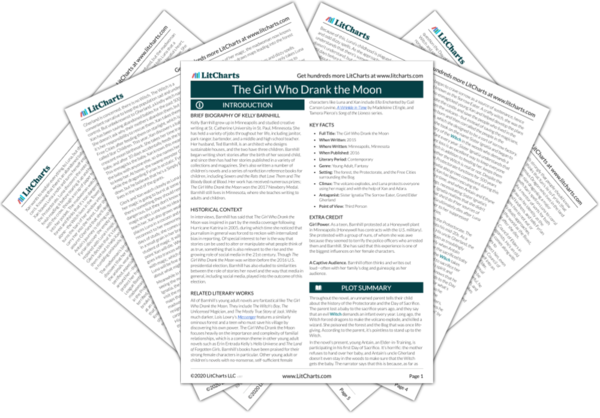Family and Love
The Girl Who Drank the Moon follows a sorrowful city called the Protectorate, which every year sacrifices its youngest infant to a Witch who supposedly demands the child. In reality, the story of the evil, bloodthirsty Witch is nothing more than a story designed to subdue the populace—although, unbeknownst to the Elders (the governing body in the Protectorate), there is a witch named Xan who, though she has no idea why a parent abandons a…
read analysis of Family and LoveStorytelling, Censorship, and Control
The Girl Who Drank the Moon introduces the reader to a world in which storytelling of all sorts reigns supreme. In the universe the novel portrays, the world itself rose up out of a story told by its creator. Meanwhile, in the town known as the Protectorate, evil agents create and promote the narrative that there’s an evil witch who lives in the forest and demands a yearly sacrifice of an infant. This story allows…
read analysis of Storytelling, Censorship, and ControlMemory, Forgetting, and the Future
The world of the novel is one that’s about to reach a tipping point: as young enmagicked Luna approaches the age of 13, her magical power grows, while Xan’s power wanes; the sleeping volcano in the woods is about to erupt after 500 years of restless dormancy; and after 500 years of acceptance and complacency in the Protectorate, Antain decides that it’s time to confront the Witch who demands infants as sacrifice and save…
read analysis of Memory, Forgetting, and the Future
Sorrow vs. Hope
One of the few things that Xan can infer from the past is that sorrow is dangerous, and that a person should hide their sorrow at all costs, though she can’t remember exactly why. The reader eventually comes to learn that this is because Sister Ignatia—formerly known as the Sorrow Eater—feeds on other people’s sorrow, and does whatever she can to create and harvest it like someone might harvest crops. While Sister Ignatia’s ability…
read analysis of Sorrow vs. Hope






